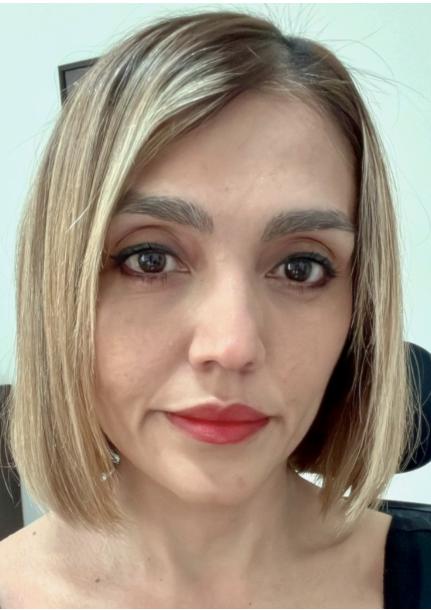Margarita Sánchez Domínguez
2023 Conference

Margarita Sánchez Domínguez, PhD
CIMAV Monterrey, México
Margarita Sánchez Domínguez is a Research Professor at CIMAV MONTERREY, she belongs to level 3 of the National Researchers System (SNI), and she is a regular member of the Mexican Academy of Sciences since 2020. She graduated from B.Sc. in Industrial Chemistry at the Autonomous University of Nuevo León (1997). She worked as a Product Engineer at PYOSA (1997-2000). She completed a PhD in Physical Chemistry specializing in surfactant systems at the University of Bristol (2004). She completed two postdoctoral stays, the first at the Institut Charles Sadron in Strasbourg (2004-2006), and the second at the Institute of Advanced Chemistry of Catalonia in Barcelona (2006-2010).
Her research topics include the synthesis of hierarchical plasmonic superstructures by electrodeposition, electrophoresis, and galvanic displacement for its application as SERS substrates, electrochemical sensors for health and environmental applications, as well as electrocatalysts. As well as the synthesis of hierarchical superstructures of metals and metal oxides by means of bicontinuous microemulsions for various applications. In addition to the development of micro and nanoformulations for their application as controlled and prolonged release systems of actives in the pharmaceutical, home care, and food industries, among others; and gene therapy nanosystems for cancer.
Plasmonic hierarchical superstructures as highly ef fi cient SERS substrates and triboelectric nanogenerators
Margarita Sánchez Domínguez 1 , M. Edith Navarro-Segura 1 , Ana Arizmendi- Morquecho 1 , Manuel Ceballos-Guzmán 1 , Jaime Alvarez-Quintana 1
1 Centro de Investigación en Materiales Avanzados, S.C. (CIMAV), Subsede Monterrey. Monterrey, Nuevo León, MEXICO
margarita.sanchez@cimav.edu.mx
Currently there is a high demand for ultrasensitive sensors for both health and environmental applications. The detection of contaminants is essential since many of these are usually harmful to health. On the other hand, the detection of cancer cells and biomarkers in early stages of the disease is essential to have greater chances of survival. In recent years, plasmonic hierarchical superstructures have played an important role in the development of new sensors with high detection capacity. These materials can be used as SERS substrates, which base their detection principle on surface enhanced Raman scattering. In this talk, several strategies for the synthesis of plasmonic nano and superstructures will be presented, as well as the evaluation of their performance as SERS substrates for the sensing of model molecules, contaminants, drugs and cancer cell lines. The synthesis strategies used were chemical synthesis, electrodeposition, and galvanic replacement. Various superstructures such as nanostars, decorated nanodendrites, and nanostructured hollow polyhedrons, based on Au, Ag, Cu and their combinations, were synthesized. 1-3 Some of the molecules detected were: rhodamine 6G, 4- aminothiophenol, crystal violet, bisphenol A, triclosan, tetracycline, vancomycin, and tramadol. Furthermore, through adequate functionalization, it was possible to speci fi cally sense a prostate cancer cell line (LNCaP). In order to extend the applications of some of these plasmonic nanostructures, we also developed a triboelectric nanogenerator- (TENG) device. 4 The fabrication of enhanced performance TENGs using Ag octahedron nano-assemblies on ITO as electrodes signi fi cantly increases the electric charge collection of the induced tribocharges. The resulting electrical output power can successfully drive low power consumption electronic devices. Taken together, the obtained results show the high potential of hierarchical plasmonic nano and superstructures for the development of ultrasensitive SERS substrates and ef fi cient triboelectric nanogenerators.
References
1. R.D. Rivera-Rangel, M.E. Navarro-Segura, A.Arizmendi-Morquecho, M. Sánchez-Domínguez. Nanotechnology 2020 , 31(46), 465605.M.E.
2. M. Ceballos, I. López, A. Arizmendi-Morquecho, M. Sánchez-Domínguez, Nanotechnology 2021 , 33(38), 385602.
3. Navarro-Segura, R.D. Rivera-Rangel, A. Arizmendi-Morquecho, I. López, J. Alvarez-Quintana, M. Sanchez-Dominguez. Applied Materials Today 2022 , 29, 101598.
4. M.E. Navarro-Segura, M. Sánchez-Domínguez, A. Arizmendi-Morquecho, & J. Alvarez-Quintana. Journal of Energy Chemistry, 2023 , 83, 478-495
